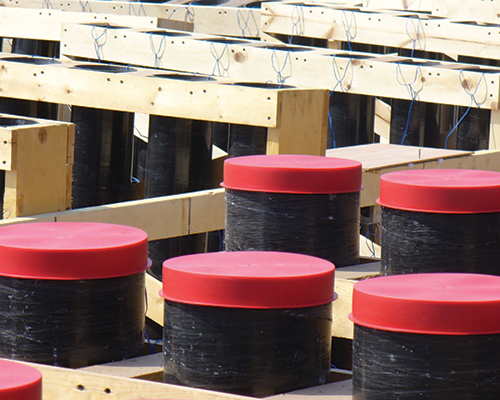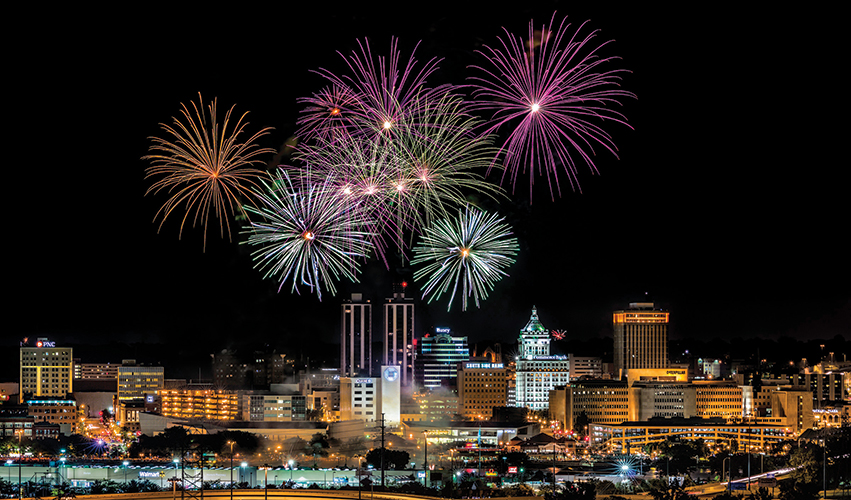Red, white and boom… in the All-American City
Independence Day is no holiday for Mike Wild. While thousands gather on the Peoria and East Peoria riverfronts to relax and watch the fireworks, he’ll be scurrying behind the scenes, coordinating the final touches on a show that requires nearly a year to coordinate.
“It’s the biggest in Illinois,” says Wild, Senior Vice President and General Manager at Alpha Media. And like the pyrotechnics behind it, it’s only getting better: larger shells and more effects, with greater intensity. About 2,000 to 3,000 shells will be launched each minute during the half-hour display.
“At smaller shows, you’ll see [a couple] fireworks go up at the same time, [with] pauses between,” Wild notes. Our pauses are only poignant, he explains. “They’re purposeful, because it’s choreographed to music.”
UnityPoint Health Red, White and Boom! got its start as the 1987 Skyconcert—a couple thousand dollars of fireworks synchronized to music from KZ-93, Peoria’s bygone Top 40 radio station (now 93.3 The Drive). It’s since blossomed into a six-figure pyrotechnic display backed by all Alpha Media stations, headlining a weekend of riverfront events, thanks to UnityPoint Health’s support since 2007.
Community Spirit
It was a perfect fit, says Debbie Simon, President and CEO of UnityPoint Health – Peoria. “The decision had a lot to do with really wanting to give back to the community. We believe strongly in the quality of a community… and quality of life is tied to quality of health. We saw this as an opportunity to show more visibly our commitment to the community.”
With more than $3,500 of fireworks launched each minute last year, the commitment could hardly be more visible. “What the partnership has allowed us to do is grow,” Wild notes. This year’s show has similar projections, with an expanded schedule of events.
“It’s more than a 30-minute firework display,” Simon explains. “It’s a whole ‘staycation,’ with several days of events and increasingly, a festival atmosphere. It’s important to recognize this event doesn’t just happen because someone says ‘I’ll fund it.’ It happens because there’s a collaborative spirit here in Peoria.”
And a huge part of that collaboration centers on Peoria’s long-lasting relationship with Melrose Pyrotechnics of Kingsbury, Indiana.
Choreographing the Sky
“We’ve been there from the beginning, when it was just a vision,” says Bob Kerns, Director of Operations. “[Peoria] was one of our very first customers, when we first started putting fireworks with music. We’ve been able to watch them grow and partner with them, all the way to where they are today.”
And Melrose Pyrotechnics has grown as well. With twice-weekly summer shows at Navy Pier; multiple Fourth of July, Labor Day and New Year’s Eve celebrations over Lake Michigan; Rockford’s annual Fourth of July Extravaganza; season-long displays for the Chicago White Sox; and other shows across the region, Kerns’ company also finds time to compete internationally. In 2014, its fireworks display shows took first place in three separate competitions in China, Japan and Vietnam.
In short, the company specializes in commanding fiery bursts of color and special effects, exploding in time to the beats and off-beats of popular hits via software. According to Kerns, Peoria’s show requires roughly 200 man-hours just to choreograph.
“[When] we’re ready to start programming, we have a show designer who will… take the music file… and create event positions within the music,” he explains. Utilizing the company’s extensive firework inventory, the pyro-composer selects the products that best match each song’s tempo, mood and style, tying different effects to each event position. It’s “the kind of synergy that fuses musical production with technical artistry,” the company touts, “to build a full-blown pyromusical event.”
It’s an interesting exercise because of the timing, says Wild. “You have to know how long it takes from the time the computer sends the message to fire one particular shell… until it actually lights the fuse and gets it up in the air… [and from] the time it comes out of the mortar to the time it explodes, and back all that time to where it’s supposed to explode in the song. Imagine doing that for 2,000 different shells per minute in a half-hour show!”
Treasures in the Hold
When the two or three tons of fireworks arrive in Peoria by truck, they’re loaded onto an ARTCO Fleeting Services barge. They come in mortars—vertical round tubes, inches to feet in diameter—which offer a different sort of challenge.
“Imagine… a bunch of toothpicks, vertical in a cup,” Wild proposes. “If the cup is only one-fourth full, then a bunch of toothpicks can be leaning at an angle. If it’s jammed full, they all have to stand straight up. Imagine the mortars on the barge in the same way. The more you put on there, the less room you have to angle. The less angle you have, the less sky you can fill up, because everything has to be shot straight up.”
Therein lies the rub; as the show has grown, so has the desire for a larger launch pad. “We want to fill a wider portion of the sky,” says Wild. “So we try to do that up and down the river—not towards land.” Several years ago, ARTCO added a second barge to the operation to create more room for mortars, which are connected with wires for show time.
“It’s all computer-operated,” he explains. “Those wires hook up to a program on a PC that is triggered by the soundtrack… which all emanates from our studio.” When the station’s transmitted signal is received by the computer on the barge, the program fires the effects, each firework exploding in perfect rhythm to the music.
“We do shows all over the country, and shooting off a barge is very common,” notes Kerns. “It makes the beauty of it all a little bit more spectacular.” It also makes safety planning more interesting.
 Ready for Anything
Ready for Anything
“The whole fireworks industry is under strict regulations,” Kerns explains, describing protocols in place by the Bureau of Alcohol, Tobacco, Firearms and Explosives, as well as the Department of Homeland Security, local law enforcement, area fire departments and the U.S. Coast Guard.
“It’s a huge project to coordinate,” adds Wild, stressing how plans to shut down river traffic on the day of the show must be made well in advance.
“[The Coast Guard] comes out and inspects the barges, along with the Fire Department,” says Kerns. “They’re with us the whole time when we’re moving the barges in and out of the waterways… We enjoy working with them on events like this because it keeps everyone safe.”
“For the most part, we’ve had pretty good luck,” Wild says. But there have been hiccups—like the year a mortar went off sideways and caused a small fire on the barge. “You don’t really want extra fire when you have fireworks all over the place,” Wild notes wryly, “but they did a good job controlling it. We did lose a little bit of the show, but I don’t think anybody noticed. Everyone walked off saying, ‘It was the best show we’ve ever seen!’ and eight percent of the fireworks didn’t even go off!” he adds with a chuckle.
One year, the show was nearly called off due to low cloud cover. “In a perfect world, you wouldn’t have a completely clear night for fireworks,” Wild explains, “because clouds—as long as they’re high enough—actually serve as a very nice backdrop.” But that evening, the clouds sat thick, below 700 feet—the threshold above which most shells explode. “This was the closest we ever came to cancelling the show, and people would’ve been upset because nobody would have understood why.”
With 200,000 spectators lining the river, Wild was on the phone with meteorologists, monitoring radars and debating options: cancel the show and send throngs of people home upset, or proceed and risk disappointing them, to the tune of thousands of lost dollars. “It was an awful position to be in!” he exclaims. Suddenly, the radars revealed a higher ceiling: the cloud cover would likely rise by 9:15pm.
“The show’s supposed to start at 9:30… so we were sitting there trying to decide. Eventually the cloud cover lifted, and we fired the show only five or ten minutes late… Nobody knew that we darn near lost the show,” he says with a smile.
 Vantage Points
Vantage Points
This Fourth of July, you might spot Wild—he’s the one working on your day off to make sure everything goes off without a hitch. Though he’s never seen the show from anywhere but Alpha Media’s control point on the Landing, he recommends sitting as close as possible, so you don’t miss some of the low-effect shells on the water. “You feel it a little more and are more a part of it when you’re closer,” he adds.
For Simon, the benefits of Red, White and Boom! are two-fold: bringing family and friends back home from far away, and showcasing the region to visitors. “It’s such a major event, and people are willing to travel for it,” she says. “And it’s not just Peoria—it’s about the region, and that’s part of the goal. Maybe in coming here, spending a weekend, staying at our hotels, eating in our restaurants, [visitors] will leave thinking about the region for the long term.”
All the work is worth the thrill, concludes Wild, who calls fireworks a “natural part” of the Fourth of July. “There is a magic to being able to sit with family and friends and experience the magnificence of these pyrotechnics exploding a thousand feet above you,” he declares. “Especially when you put a music soundtrack to it—it evokes a lot of emotion. And because it is an American phenomenon that we’re all used to, there’s a comfortable and enjoyable aspect to it that is unmatched.” a&s
The 2016 UnityPoint Health Red, White and Boom! Celebration kicks off on Friday, July 1st and runs through Monday, July 4th. Weekend events include several concerts, an outdoor dance party, a bags tournament and street performers, as well as the July 4th fireworks show, which starts at 9:30pm. For a complete schedule of events, visit redwhiteandboom.us.


